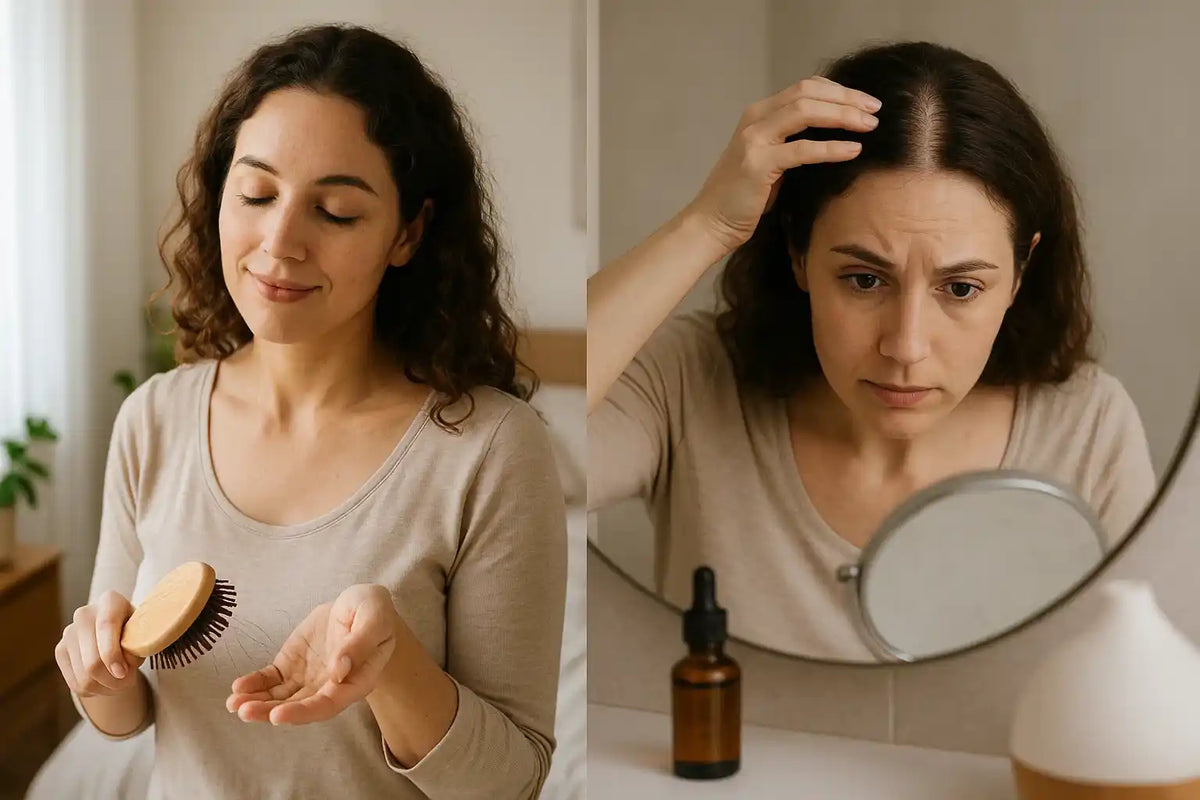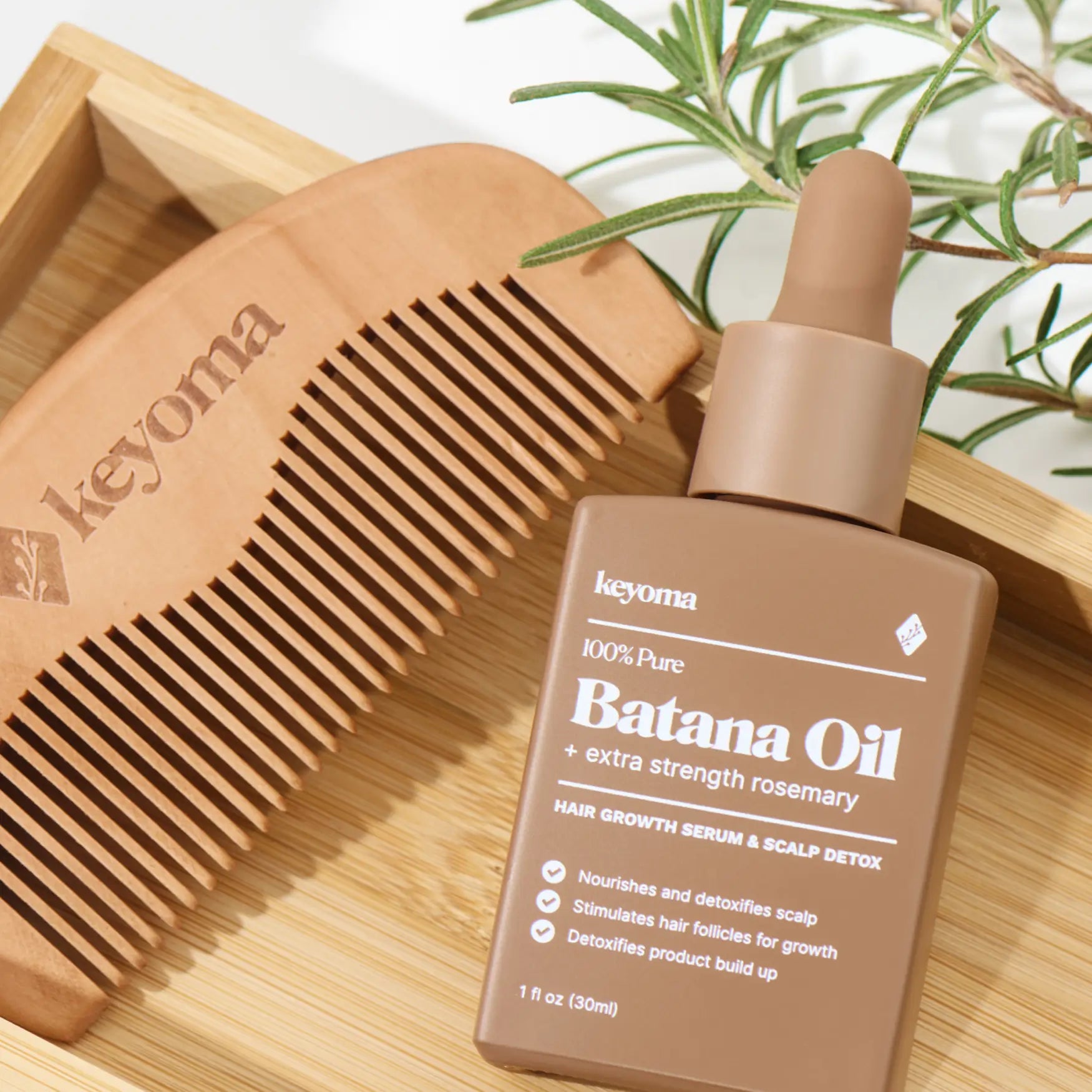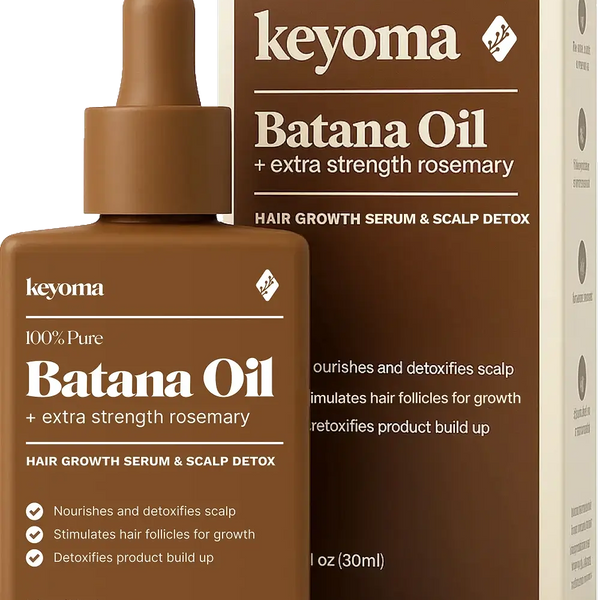In this article
As we get older, our hair follicles shift—just like the rest of our body—which leads to more shedding and even hair loss.
While both look similar, shedding and hair loss come from different causes and often need different solutions.
Understanding that difference helps us choose the right care for our hair.
What Hair Shedding Looks Like
Our hair sheds naturally as part of its regular growth cycle.
The American Academy of Dermatology says we lose around 50 to 100 strands daily. That might sound like a lot, but with about 100,000 follicles on your scalp, it’s normal.
This shedding happens during the exogen phase—the stage right after telogen, when your body gets ready to release old strands and restart growth.
Telogen lasts about three months. Exogen wraps up in just a few days.
While shedding is expected, too much of it could point to something deeper than the usual cycle. Keep an eye on the amount and how long it lasts.
What Hair Loss Looks Like
Hair loss can feel overwhelming—and it can affect any of us, no matter our age or gender.
It happens when strands fall out from the root, not just break off.
Here are the main types of hair loss you might notice:
- Anagen effluvium
- Androgenetic alopecia
- Traction alopecia
- Telogen effluvium
- Alopecia areata
In simple terms, hair loss can come from inside or outside your body.
Internal triggers include immune reactions or inflammation. External causes might be harsh products, certain medications, or tight styles that pull on your roots.
You can also lose hair from stress, pregnancy, or not getting enough nutrients.
In some cases, hair loss runs in the family or comes from hormonal shifts—and you might need a doctor’s help to manage it.
Shedding or Falling Out? How to Tell

It’s not always easy to know if you're dealing with normal shedding or something more serious.
That’s why it helps to check in with a hair specialist. Ignoring ongoing hair loss can make it harder to treat later—you could end up needing more than medication, like a transplant.
If you're unsure whether it’s time to seek help, here are a few signs to help you spot the difference between shedding and true hair loss:
Onset
Hair loss: It might hit suddenly, but it often builds gradually over time.
Excessive hair shedding: Telogen effluvium usually shows up a few weeks to a few months after a trigger—like stress, medication, or illness.
On the other hand, damage from things like summer heat, styling tools, or strong chemicals tends to sneak up. You might not notice the shedding until months later.
Duration
Hair loss: How long hair shedding lasts depends on the cause—and how we respond.
Excessive hair shedding: Telogen effluvium usually clears up within 6 months, though it can last longer.
If medication causes shedding, it often continues until you stop the treatment.
Scalp issues can lead to shedding that sticks around until you treat the underlying condition.
Hair loss from sun, heat, or chemical damage might take months to improve, depending on how you care for your hair in the meantime.
Affected Area
Hair loss: You might notice hair thinning in specific areas on your scalp.
For men, it often starts at the hairline, temples, or crown. For women, it usually shows up around the crown or along the part.
Excessive hair shedding: When you're dealing with general shedding, it usually spreads across your whole scalp.
If the shedding comes from a scalp issue, it often stays in one spot.
With traction alopecia, you’ll likely see more fallout around your hairline and temples—where tight styles pull the most.
Progression
Hair loss: It usually gets worse if we don’t treat it.
Excessive hair shedding: Shedding, on the other hand, often stays the same once it starts and doesn’t continue to spread.
Other Symptoms
Hair loss: None
Excessive hair shedding: With telogen effluvium, you might not feel anything beyond the shedding.
Still, over 40% of people report scalp redness or a burning sensation known as trichodynia.
If a scalp condition causes the shedding, you could also deal with redness, swelling, soreness, itching, tingling, flaking, or even bumps and sores.
When outside factors like sun or heat are the trigger, your hair might feel dry, rough, or weak—and break off with little effort.
How to Slow Hair Loss and Stop Excessive Shedding
You don’t need to stop natural shedding—it’s part of the cycle and helps refresh your hair.
But you can take steps to reduce hair loss and keep shedding from getting out of control:
- Work on lowering stress in your daily life—it impacts your hair more than you think.
- Keep your scalp hydrated with moisture-rich products and gentle care.
- Use natural oils to nourish your roots and support growth.
- When you're outside, protect your hair from UV damage with sun-safe sprays or covers.
- Cut back on harsh products like dyes, relaxers, or bleach—they weaken your strands over time.
- Limit how often you use heat tools, and always apply a heat protectant before styling.
- Eat a balanced diet packed with hair-supporting nutrients like vitamin C, vitamin E, and biotin.
- Avoid tight hairstyles or heavy extensions too often—they can lead to traction alopecia.
- Support growth with scalp massages, derma rollers, or red light therapy to keep follicles active and healthy.
Does Shedding Mean Regrowth?
Usually, natural shedding during the exogen phase leads to new growth once the cycle resets and the anagen phase begins.
But if you’re dealing with chronic telogen effluvium—or shedding caused by medication, harsh styling, or environmental stress—regrowth won’t happen until you remove those triggers.
You might need to adjust your habits or treatments to help your hair recover.
If you’ve had a hair transplant, shedding a week or two later is normal. That’s called shock loss—your grafts enter a resting stage to heal. New growth should begin within a few months and continue over the next year.
How to Treat Ongoing Shedding or Loss

Excessive shedding usually stops on its own once you address the root cause, so you don’t need ongoing treatment.
Hair loss, though, often needs a more active approach.
You have several science-backed options to treat it—here are some of the most common ones:
- Batana Oil - a nutrient-rich oil with the benefit of strengthening hair, reducing breakage, and supporting scalp health.
- Minoxidil – a topical treatment that widens blood vessels, helping more nutrients reach your follicles and support growth.
- Finasteride – one of the most used options for pattern hair loss. It lowers DHT levels but isn’t usually recommended for pre-menopausal women.
- Dutasteride – a powerful DHT blocker similar to Finasteride, though not FDA-approved.
- Steroid creams – often used to manage autoimmune-related hair loss, like alopecia areata.
- Dermarolling – this method uses a tool to create tiny punctures in your scalp, which boosts healing and helps your scalp absorb treatments better.
- Low-level laser therapy – uses targeted light to stimulate cell activity and energize your follicles.
- Hair transplant – a surgical method where follicles from one part of your scalp are moved to a thinning or bald area for lasting results.
Stop Hair Shedding and Excessive Hair Loss with Keyoma
Hair shedding and hair loss can feel confusing and frustrating—but you’re not alone, and it’s not hopeless.
If your strands are thinning, your scalp feels irritated, or your hair just doesn’t bounce back like it used to, there’s a reason behind it. And more importantly, there’s something you can do about it.
At Keyoma, we handcraft our batana oil with rosemary to help you take control at the root—supporting circulation, reducing breakage, and giving your follicles the nutrients they need to thrive.
Whether you're seeing hair in the shower or noticing visible thinning, you deserve a solution that works with your body, not against it.
Start your recovery with clean, proven ingredients that support real growth.
Your scalp is ready. Your hair can grow back stronger.
Let’s begin, together.
Featured Product
100% Pure Batana Oil + Rosemary









